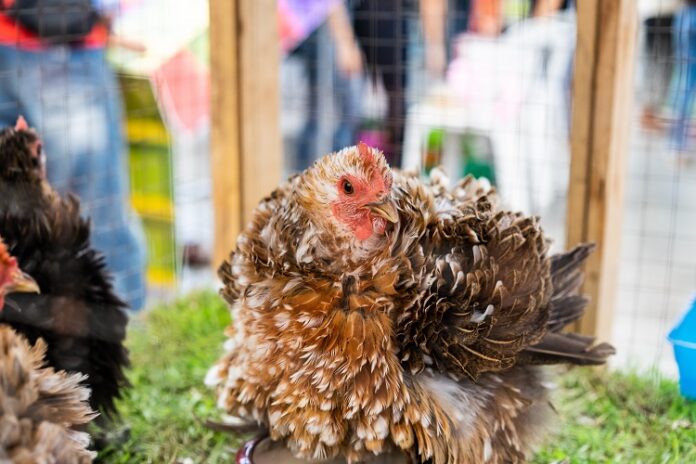Last Updated on July 2, 2021 by Fumipets
What exactly is a frizzle, you may wonder? It is, without a doubt, a chicken, but one with a distinctive appearance and some unique requirements to complement.’
What more can you want of hens than to be entertaining, conspicuous, and lovable?
They are regarded differently in various nations, as we will see, yet they are universally adored.
In this article we will discuss this unusual-looking bird and whether it would make a good addition to your backyard flock.

Overview
| Frizzle Chicken | |
|---|---|
| Beginner Friendly: | Yes (docile and friendly). |
| Lifespan: | 6-8 years. |
| Weight: | Hen (5-6lb) and Rooster (7-8lb). |
| Color: | Various (Buff and Brown most popular). |
| Egg Production: | 2-4 per week. |
| Egg Color: | Cream or Brown. |
| Known For Broodiness: | Yes. |
| Good With Children: | Yes. |
| Cost of Chicken: | $3-$8. |
History
The Frizzle is not a new breed; in fact, the earliest mention of them dates back to the 1600s.
Charles Darwin also noted them, referring to them as Caffie Fowl. In his papers, he indicated that they were mostly discovered in India.
He must have learned this from someone else since he never visited India.
The frizzle gene seems to have originated in the Far East (maybe China) and the East Indies.
The birds were introduced to western nations as curiosities and breeding stock as interest in this unusual-looking bird grew.
Cochin, Polish, Plymouth rocks, and other breeds are more prone to frizzing than others.
The most common breeds frizzled are Japanese bantams, although many other breeds may be frizzled as well.
A Sizzle is created when a Silkie and a Frizzle are crossed.
So, what does Frizzling entail?
Frizzing occurs when a hen’s feathers begin to curl upward and outward from the body rather than resting flat against the body as they do in a ‘normal’ hen.
The shaft of the feather begins to twist and curl, giving the feathers their distinct look.
An imperfect dominant gene causes frizzing. Frizzling may be caused by only one copy of the gene in a single bird. The presence of a copy in both parent birds will result in a high rate of frazzles.
Due to the ‘mf’ gene, the amount of frizzling you receive on a bird may be highly varied.
This is the ‘frizzle modifier’ gene, and it might make your frizzle chick seem more normal if it’s present.
Frizzle is not bred to Frizzle by responsible breeders. You’ll get Frazzle or ‘curly’ chicks as a result of this. It is legal to breed Frizzle to a regular hen, resulting in a mix of regular and frizzled offspring.
Frazzles are a sensitive creature. The feathers may be so fragile that they shatter at the slightest touch, causing patchy feathering or even complete baldness.
Normal x frizzle = 50% frizzle + 50% normal
Frizzle x frizzle = 25% normal, 50% frizzle + 25% frazzle
Frazzles may also be connected to heart and other medical problems, which typically implies the chicks won’t live very long or live a very normal life.
Frizzle Breed Standard
Frizzles are recognized as a breed in Australia, the United Kingdom, Ireland, Italy, Slovakia, the Czech Republic, France, and Germany.
This may be a bit puzzling because frizzles are classed as a form of plumage in the United States and elsewhere.
This isn’t to say you can’t show them off. You’d put them on display as breed specimens, i.e. The bird would be assessed for conformance to the standard for that breed, such as Cochin or Polish.
As frizzles, cochins seem to compete well in the bantam division.
They are recognized as a breed type in the South Asia, Phillipines, and Java classes.
They have a short, robust beak that is yellow/horn in colour, and brilliant, red eyes.
The wattles and ear lobes are medium in size and crimson in colour.
They should be full-breasted with short, wide, upright bodies, huge tails, and extended wings. The combs are solitary and standing vertically. The legs and feet of the birds should be clean and golden in color. In the black/blue colours, some black shading is permitted. Each foot is made up of four toes.
Weight varies based on the Frizzle breed, therefore size varies as well. Standard Frizzles should weigh approximately 8 pounds for males and 6 pounds for females, unlike Bantams that weigh 24-27 oz for males and 20-24 oz for females.

Appearance
Appearance hey look to be a bundle of wild, curly feathers with legs, similar to a feather duster!
The feathers of a chicken might be “curly and neat” or “wild and windswept,” depending on the breed. However, they should all seem soft rather than sharp.
The main variation in the feathering look is that the chicken will assume the form of its breed. Buff, black, black-red, brown-red, blue, Columbian, cuckoo, duckwing, pyle, red, spangled, and white are all acceptable colours.
Other colours exist, as breeders continue to experiment with color patterns, but the ones mentioned above are the most frequent.
Frizzles are available in two sizes: regular and bantam, with the latter seeming to be more popular at the moment.

Temperament
The Frizzle is a beauty, except from the fact that it looks like one. They have a pleasant, kind, and nice demeanor. They are gentle and docile, and they accept being handled well; in fact, many of these tiny darlings end up as lap chickens, living a life of opulence.
As a result, you may face a broad range of temperaments while dealing with this exotic breed. The mature frizzle’s temperament is also influenced by the breed to which he was bred. Some of the non-traits frizzle’s may peek through.
While the frizzle is an interesting ornamental breed, it also requires a lot of upkeep. It’s the Golden Doodle of the chicken world, in a manner. A lovely breed with high grooming and cleanliness requirements.
In extreme weather circumstances (for example, whether it’s cold, hot, or they become wet), the frizzle has unique requirements. If you don’t have the time to devote to making sure your frizzle is well groomed, try a breed like the Dominique.
Egg Laying
The Frizzle is well-known as an exhibition bird in many countries, although it is not well-known for its capacity to produce eggs. In the laying aspect, it’s rated as bad to fair.
They aren’t prolific layers, although they may produce 120-150 cream or coloured eggs every year. This works out to roughly two or three tiny to medium eggs every week.
They do become broody every now and then, and they make excellent mothers.
The chicks may take a little longer to feather out than typical chicks, so they may require a little extra time in the brooder.
Coop Setup
Each Frizzle Chicken will need around 4 square feet of coop space. Bantams, on the other hand, will need a bit less room to be comfortable.
They should each have 8-10 inches of roosting area. If your Frizzles are mixed breeds, ensure sure there are adequate roosting spots for them to walk away if they are being picked at. Frizzles are unable to fly, thus their perches must be closer to the ground so that they can reach them at night. A ladder to the perch would also be useful.
You may use normal 12 by 12 inch boxes for nested boxes.
Special Needs
Because of their feathering, Frizzles need specific care. Because they are unable to fly, perches should be placed lower down so that they may reach them; otherwise, they may ‘pile up’ on the bedding.
If you decide to let them roam free, make sure the environment is predator-proof since they can’t fly up and away from danger.
Although owners claim that Frizzles are tough, they should be closely watched in severe cold since the feathering does not insulate as effectively as ordinary feathers. For the same reason, excessive rain and snow exposure should be avoided.
Frizzles finds any severe weather, including heat, cold, rain, and snow, to be a struggle. Because the feathers perform a poor job of maintaining the chicken’s body temperature, more care should be taken to assure their safety.
Because head feathering may sometimes obstruct eyesight, the tips of the feathers may need to be clipped very little. They should only be clipped to the point where they can see.
If you are exhibiting your birds, cutting the ends off the feathers to enable the bird to see is not appropriate. If your birds get scared or frightened when you enter the coop or touch them, it’s possible that their head/facial feathers are preventing them from seeing well.
As you approach the coop, try whistling, singing, or just conversing to them to let them know you’re not a predator!
Is The Frizzle Chicken The Right Choice For You?
Many Frizzle keepers are enthralled by their eccentric little birds! The Frizzles seem to be quite pleasant and cheerful birds, as well as quiet and docile.
They are definitely a family-friendly bird, and children adore them! Your neighbors will be curious as to where you obtained that “strange little bird.”
They are mainly maintained as a “show bird” in many nations, and they perform well in the ring. They appear to like the attention and appear to bear it well.
Because they are easily intimidated by more forceful breeds, keep an eye out for feather plucking and other similar habits.
If the situation worsens, you’ll need to remove your Frizzles from the rest of the flock. They get along nicely with delicate breeds like Polish and Cochins.

Conclusion
Frizzles are a lovely and adorable addition to your flock. They’re a non-aggressive bird that like to roam free or hang out with the other ladies in captivity.
They are difficult to top as show birds or “lawn decorations,” but they have a lot to offer in terms of calm, peaceful companionship.
Because they are so well behaved, many people keep these tiny darlings as “house chickens.”
The Frizzle is the bird to have if you want a bird that is always cheerful, non-demanding, and a joy to look at.


















